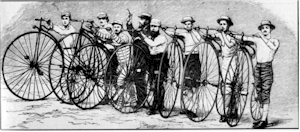

Tower and Town, June 2016 (view the full edition) (view the full edition)Early Cycling And The Great Bath RoadIn the 1870s and 1880s the velocipede - an iron machine with the pedals ('treadles') on the front wheel had morphed into the 'ordinary' or high bicycle (the penny farthing) with a huge front wheel (still carrying the treadles) and a prodigious turn of speed. Because it was ungeared - no chain - the high speed could only be gained by having a wheel as big as the rider could get his leg over. This had the incidental advantage of conferring a much smoother ride over the rough roads of the time (Mr Dunlop's pneumatic tyre had not been invented) but put the intrepid rider at risk of a header over the handlebars if the front wheel hit a pothole or other obstacle. Still the intrepid were plentiful; cyclists liked to show off their athleticism and manufacturers the excellence of their new designs, and the Bath road became a place to do this, as our 1874 picture shows.  In 1886 the Bath Road Club was founded in Hayes in west London and has fostered social and competitive cycling ever since. Alexander Kirk Wilson |